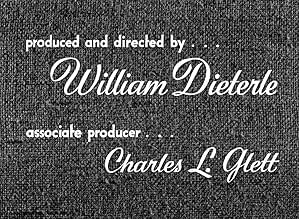Un contadino del New Hampshire del diciannovesimo secolo fa un patto con Satana per il successo economico, quindi arruola il famoso oratore Daniel Webster per strapparlo dal suo contratto.Un contadino del New Hampshire del diciannovesimo secolo fa un patto con Satana per il successo economico, quindi arruola il famoso oratore Daniel Webster per strapparlo dal suo contratto.Un contadino del New Hampshire del diciannovesimo secolo fa un patto con Satana per il successo economico, quindi arruola il famoso oratore Daniel Webster per strapparlo dal suo contratto.
- Vincitore di 1 Oscar
- 2 vittorie e 1 candidatura in totale
- Spectator
- (non citato nei titoli originali)
- Hank
- (non citato nei titoli originali)
- Poker Player
- (non citato nei titoli originali)
- Woman
- (non citato nei titoli originali)
- Martin Van Buren Aldrich
- (non citato nei titoli originali)
Trama
Lo sapevi?
- QuizWilliam Dieterle had a habit of directing with white gloves on. Robert Wise said that everyone thought it was because he had a germ or dirt phobia. During shooting of one scene, Dieterle noticed there wasn't enough mud on a carriage wheel. He pulled off his gloves, grabbed some mud, rubbed it onto the wheel, then wiped his hands on his pants and put the gloves back on to continue directing.
- BlooperShortly after filming had begun, Thomas Mitchell fractured his skull and was replaced by Edward Arnold. Not many scenes had been shot, none were reshot, so Mitchell is still visible in some scenes. [Note: entries in the Trivia section indicate that all of Mitchell's scenes were reshot.]
- Citazioni
Mr. Scratch: You shall have your trial, Mr. Webster. But I'm sure you'll agree, this is hardly the case for an ordinary jury.
Daniel Webster: Let it be the quick or the dead, so long as it is an American judge and an American jury!
Mr. Scratch: 'The quick or the dead!' You have said it.
[he stomps on the barn floor; a door opens]
Mr. Scratch: You must pardon the leathery toughness of one or two.
Jabez Stone: [afraid] Mr. Webster!
[a line of ghosts begin entering from the trapdoor]
Mr. Scratch: Captain Kidd - he killed men for gold. Simon Girty, the renegade - he burned men for gold. Governor Dale - he broke men on the wheel. Asa, the Black Monk - he choked them to death. Floyd Ireson and Stede Bonnet, the fiendish butchers. Walter Butler, King of the Massacre. Big and Little Harp, robbers and murderers. Teach, the Cutthroat. Morton, the vicious lawyer... and General Benedict Arnold. You remember him, no doubt.
Daniel Webster: A jury of the damned...
Mr. Scratch: [laughs] Dastards, liars, traitors, knaves. Your suggestion, Mr. Webster - 'the quick or the dead.'
Daniel Webster: This is outrageous, I asked for a fair trial...
Mr. Scratch: Americans, all.
- Curiosità sui creditiFor some prints released under the title "The Devil and Daniel Webster", the opening credits start with the phrase "in front of the camera..." followed by a list of names only of the primary cast (no character names) and then the phrase "in back of the camera..." followed by a list of names only of the primary production crew, without their job roles, ending with the phase "all collaborated on the picture...." Then the title card is shown, with a story credit to Stephen Vincent Benet, and the note "this picture was originally shown with the title 'all that money can buy'." The title card is all in lower case. Finally, the opening prologue is shown as noted in another crazy credit item.
- Versioni alternativeOver the years, this film was re-released more than once, partly because of its poor box office, and gradually cut down to 85 minutes. It remained in this form for many years, until it was recently restored to its full length. When this was done in the 1990s, it was unfortunately all too easy to tell which sections are restored... all the footage from the 85 minute version was in absolutely pristine, mint condition, while the long-lost, formerly missing footage has less than perfect sound and picture quality. However, the quality has been considerably improved on the DVD and on recent TV showings.
- Colonne sonoreCome, Ye Thankful People, Come
(uncredited)
Music by George J. Elvey
Lyrics by Henry Alford
I più visti
- How long is The Devil and Daniel Webster?Powered by Alexa
Dettagli
- Data di uscita
- Paese di origine
- Lingua
- Celebre anche come
- The Devil and Daniel Webster
- Luoghi delle riprese
- Azienda produttrice
- Vedi altri crediti dell’azienda su IMDbPro
- Tempo di esecuzione1 ora 47 minuti
- Colore
- Proporzioni
- 1.37 : 1
Contribuisci a questa pagina






































